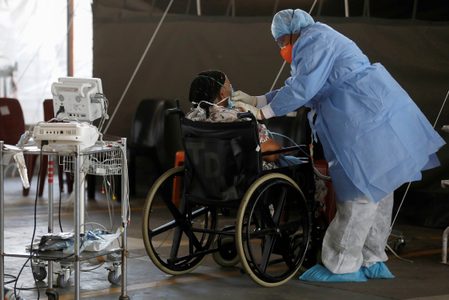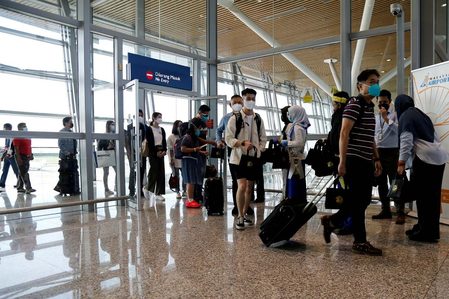SUMMARY
This is AI generated summarization, which may have errors. For context, always refer to the full article.
![[FIRST PERSON] Of bronchodilators and steroids: My journey with long COVID](https://www.rappler.com/tachyon/2022/03/tl-long-covid.jpg)
My family contracted COVID at the height of the Delta variant surge in August of 2021. There were 13 of us who got COVID, including my then five-month-old grandson, and my wife, who was hospitalized at The Medical City for end-stage renal failure, congestive heart failure, and stroke. We all got well from COVID and I even managed to write about this experience in a previous article, but unfortunately, the virus has contributed to the passing away of my wife on September 19, 2021.
At the height of my infection with COVID, I was suffering from mild symptoms – 38 centigrade fever and tightening of the chest, but my oxygen levels, blood pressure, and pulse rate were all good. After the mandatory 14-day healing period, I exhibited no more symptoms and was declared free from the virus. At that time, there was no need to have a person tested if after 14 days all symptoms were gone. So, I got my fit-to-work certificate after two weeks and I felt good. Being a physically active person, I started doing my half-hour brisk walking, and during the weekends, I would bike around the UP campus for about an hour.
The beginnings of long COVID
About a month after my wife died, I suddenly got bouts of chest tightening and difficulty of breathing. My pulmonologist immediately put me on bronchodilators administered through a nebulizer. I was doing 4-5 sessions a day, and when the episodes did not seem to stop, my doctor also put me on a twice-a-day steroid inhaler. The symptoms seemed to improve around mid-November but did not totally go away. Mind you, at that time, I was very much in grief, and the emotions were raw and untamed. I asked my doctor if this was the cause of my broncho spasms and he believed that this contributed to, but was not the cause of, my ailment. He introduced me to the term “long COVID,” meaning that one exhibited symptoms of COVID long after the virus had left.
The broncho spasms that I experience is similar to asthma where the chest tightens and it becomes difficult to breathe. But I did not have any palpable trigger like the smell of paint or perfume, no wheezing, and it was just a persistent tightening. On good days, it was just a slight bothersome tightening, but on other days, it was a debilitating spasm; when I needed to take additional medication, my appetite was affected and I had to take a rest or nap in order to calm the spasm. It became very hard to concentrate, but my oxygen levels were normal and my pulse rate slightly elevated.
Because my long COVID was becoming very bothersome, I started acupuncture sessions to strengthen my energy zones, heal the lungs, and improve my overall condition. I could feel a palpable improvement through acupuncture, but the spasms persisted. I sought the help of another pulmonologist for a second look, and this time she put me through a high-resolution CT scan and a pulmonary function test (PFT). The CT scan revealed that I had minor fibrosis (5/25) in my two upper lobes and my PFT was normal. So, my doctor cleared me to begin my conditioning exercises, and very quickly I engaged my long-time trainer and physical therapist to make me a program which I am following only very recently, around a week ago.
Getting very curious, I started reading many articles on long COVID. It turns out that aside from bronchial spasms, there are many other aspects of long COVID. “According to the CDC, the most common lasting symptoms are fatigue, shortness of breath, cough, joint pain, and chest pain. Other issues include cognitive problems, difficulty concentrating, depression, muscle pain, headache, rapid heartbeat, and intermittent fever.”
Then I started asking around, among friends, family, and colleagues about long COVID. Apparently, it seemed the issue was quite common and familiar. A dear friend of mine who got COVID in its early days (around May of 2020) recovered after a long confinement in the hospital, but still up to now feels that she has inadequate breathing. Another friend has volunteered that during Zoom meetings, a colleague seemed to get lost in the conversation and could only get back on track after a few minutes. My second pulmonologist also said that she had a colleague, a surgeon, who could only be in the operating room for 20 minutes, because she does not have the stamina nor the concentration to carry on the surgery. The husband of my niece had inflammation of the internal organs including the heart. Another friend could only sleep at night with an oxygen concentrator.
My search for solutions to long COVID has led me to Facebook pages on support groups for long COVID, and the one that I joined already has close to 50,000 members and counting. A key message that the people posted on this page was that the doctors did not seem to understand what was going on with their post-COVID ailment.
I suddenly got the impression that long COVID was more serious than I thought it was. From just a purely personal issue I had with my breathing, I realized that this was a problem that had far serious consequences than I had imagined. My acupuncturist also suggested that I follow the writings of Dr. Nicholas Christakis, a medical doctor, a virologist and a sociologist out of Yale University in Connecticut. In his book Apollo’s Arrow: The Profound and Enduring Impacts of Coronavirus on the Way We Live, he compared the current first phase of COVID very much like a tsunami, where we are hanging on to dear life, and the impact of the waves seem to engulf us and throw us around violently. He has predicted that in the year 2022, this phase of COVID will subside significantly due to the twin effects of increased vaccination and increased immunity due to milder versions of COVID like Omicron. He then identifies 2023 and 2024 as the intermediate phase of COVID, very much like when the tsunami waves have subsided. The swirling waters may have receded, but then it is time to assess the damage that has been caused. In a COVID sense, this includes taking a deep dive into the impact of long COVID, aside from the sustained impact of the pandemic on the economies of the world, its health systems, and it governance structures.
Ways forward
On a personal level, I think that I am on the mend. I am working on the theory that COVID and my grieving has resulted in the weakening of my lungs, and its heightened sensitivity to triggers (I have to admit that the smell of paint and sudden cold temperatures have triggered spasmic behavior of my airways). And so, the solution seems to be to strengthen my lungs and get a grip on my grief. On the second one, I believe that I have become stable in getting a hold of my grief. After almost six months since my wife died, my grief has become modulated, and I tend to celebrate more the good times that we had instead of dwelling on the loss. That helps. On the first one, I can now start to exercise under medical supervision, with the aid of bronchodilators. I figure that the lungs and the bronchus are also muscles, right? And if you don’t use it, you lose it. If they remain weak, then it affects the whole body. So, my prescription for conditioning exercises is spot-on.
On a general level, I have also encouraged my friend who is a key official in a big Metro Manila hospital to start a community of practice around long COVID. I told him about my condition, and the fact that I think the medical community can really help a lot of people deal with this malaise. The medical consensus indicates that we are in early days on this phenomenon, and a lot more study is needed. I also think that developing expertise around this area makes financial sense over the long term. He said that this kind of novel medical areas start with a registry and survey of patients who have experience in this syndrome, and I gladly volunteered to be a subject of whatever survey may be needed to put a finger and a name to this disease.
Just last night, I was telling my dear friend, a medical director of a hospital in Baguio, that my fear is that if this phenomenon is not adequately studied and brought to the consciousness of the community, then its symptoms and after-effects could just be swept under the rug, and be treated as just ordinary fatigue (perhaps cured by better nutrition) or just an ordinary cough (treated by cough medication and antihistamines) rather than studying its relationship with COVID and the possible repercussions of the virus on a host of human activity. Maybe, people like me with long COVID symptoms could be part of a bigger study that could identify what long COVID is and why it is happening. By so doing, then other people, especially those who do not have the wherewithal to have themselves treated for long COVID, may benefit from the practices and processes that such a study could engender, to alleviate the impact of the disease.
Conclusion
Long COVID is here to stay. I looked at the statistics of how many Filipinos have contracted COVID as of today (which is 3.663 million) and started to wonder how many of them have long COVID symptoms. That figure could be extrapolated from a survey with a representative random sample of patients who have had the virus, and how many of them have long-term symptoms, what they are feeling, and how they are coping. The government has to come in to include long COVID as part of the universal health care program. How can the people suffering from this malaise be supported by Philhealth, the medical insurance community, and the medical profession in general?
So many questions have been triggered by my journey with long COVID. I know I have suffered and it is not enough for me that I am on the mend. It also is important that I bear witness to others who may be suffering similarly, and try to figure out what steps can be taken in the short and long term to understand this debilitating disease, figure out its root cause, and look for cost-effective solutions. – Rappler.com
Hector Soliman is a public interest lawyer of around 40 years and has three lovely grandchildren.
Add a comment
How does this make you feel?


There are no comments yet. Add your comment to start the conversation.